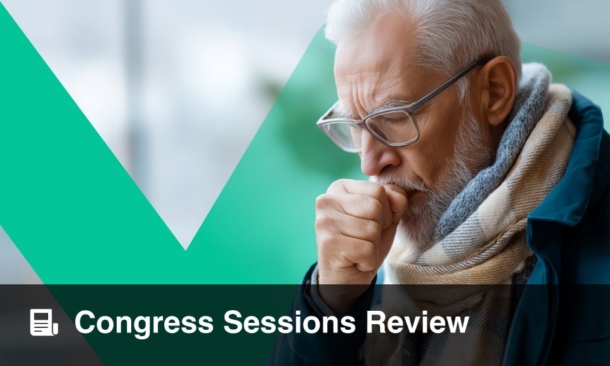Author: *David Mannino1,2
1. COPD Foundation, Miami, Florida, USA
2. University of Kentucky, Lexington, USA
*Correspondence to [email protected]
Citation: Respir AMJ. 2023;1[1]:17-19. DOI/10.33590/respiramj/10307281. https://doi.org/10.33590/respiramj/10307281.
![]()
CLINICAL TRIALS
Several key clinical trials had data presented. One was the BOREAS trial, which examined the use of dupilumab, a monoclonal antibody that blocks the shared receptor component for IL-4 and IL-13, key drivers of Type 2 inflammation in patients with eosinophilic COPD.1 Results showed that patients who received an injection of dupilumab every 2 weeks had a significant reduction in COPD exacerbations, in addition to an improvement in their lung function and an improvement in their measures of quality of life. A second trial of this therapy is awaiting completion. If this study replicates the findings of the first trial, it will most likely result in the first biologic therapy that is approved to treat COPD in the USA (pending approval by the U.S. Food and Drug Administration [FDA]).
A second presentation looked at results from ENHANCE-1 and ENHANCE-2, studies that reported on the use of ensifentrine, a nebulized therapy used twice daily.2 Ensifentrine is a selective dual inhibitor of the enzymes phosphodiesterase 3 and 4, combining bronchodilator and non-steroidal anti-inflammatory activities in one compound. Results of these trials showed both a significant reduction in exacerbations and an improvement in lung function. If this therapy is approved by the FDA, it will mark the first new class of therapy approved for the treatment of COPD in over 10 years.
INTERPRETATION OF SPIROMETRY
A current controversy in COPD and the respiratory world is how race should be used in the interpretation of spirometry. On one side of the discussion is the belief that ‘race’ is a term that is problematic, and may reflect factors other than ancestral ones (malnutrition, environmental factors, deprivation, etc.) that differ between racial groups, and that the best solution is to use ‘race-neutral’ prediction equations. The counter argument is that carefully done studies have demonstrated differences in lung function between racial groups, and that using a race-neutral approach risks categorizing people with ‘normal’ lung function as abnormal and vice versa, based on their race and what prediction equations are used. Although there were no definitive solutions presented, one approach may be to acknowledge the limitations of our current classification system of normal and abnormal to include an ‘indeterminant’ classification.
GLOBAL INITIATIVE ON CHRONIC OBSTRUCTIVE LUNG DISEASE 2023
The Global Initiative on Chronic Obstructive Lung Disease (GOLD) updated their strategy document in late 2022, and several sessions looked at the components of this update. These included the role of exacerbations in COPD therapy and how exacerbations are classified. Although the update called for implementing the new criteria for exacerbation severity based on physiologic metrics, the practicality of this approach in real-world settings has been questioned. Another important concept in the GOLD 2023 strategy is the concept of ‘etiotypes’, looking at sub-groups of COPD based on etiology (i.e., smoking, infections, developmental issues, genetics, etc.). The hope is that different subgroups of COPD might result in different interventions and improved outcomes.
DISEASE PROGRESSION IN CHRONIC OBSTRUCTIVE PULMONARY DISEASE
Another important concept discussed at several sessions relates to how COPD is diagnosed and progresses. What is important here is the reality that, by the time lung function impairment is noted, a great deal of damage has already been done. If one is to find a therapy that truly modifies disease, COPD will have to be detected much earlier in its course. For example, one session highlighted what happens to people with normal lung function but COPD risk factors, such as smoking and respiratory infections. Some take-away messages were that even among those with normal lung function at baseline, follow-up lung function demonstrating decline increases the likelihood of COPD development. Frequent respiratory infections increase this risk. These respiratory infections also result in a loss of the normal diversity that occurs in microorganisms found in the lung, which raises the possibility that efforts to return this diversity to a more ‘normal’ state may be a potential therapeutic approach.
ADVANCED CHRONIC OBSTRUCTIVE PULMONARY DISEASE
A final topic worth noting is what happens in advanced COPD, where patients may not respond to medical therapies. Some of the advanced options being investigated include bronchial rheoplasty, which alters the epithelium of the lung in patients with chronic bronchitis that does not respond to typical therapies. Although endobronchial valves have been available for use globally for several years, many questions remain about their optimal use, including which lobes should be targeted and whether the procedure should be sequenced. Long-term data from existing trials were also presented demonstrating the safety and efficacy of endobronchial valves for COPD after 5 years of follow-up.
CONCLUSION
The above represents just a few of the COPD-related highlights presented at the 2023 ATS meeting. The ATS has provided a searchable directory of the conference presentations that can be viewed by both paid attendees and non-attendees.








